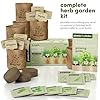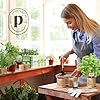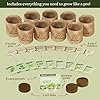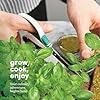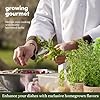DIIYIV 2PCS 12x4x1FT Galvanized Raised Garden Bed Kit,Vegetable Boxes-Rectangle Metal Flower Box,Large Planter Raised Beds Outdoor Garden for Planting,Fruit,Herb-Sliver
10% OffQuictent Raised Garden Bed with Cover Outdoor Galvanized Metal Planter Box Kit, w/ 2 Large Screen Windows Mini Greenhouse 20pcs T Tags 1 Pair of Gloves Included for Growing Vegetables 6x3x1ft (Clear)
26% OffAre you tired of throwing away food waste and wondering how to reduce your carbon footprint? Composting is the answer! In this article, we’ll cover everything you need to know about composting, from what it is to tips for successful composting. Let’s get started!
What is Composting?
Composting is the process of breaking down organic matter into a nutrient-rich soil amendment that can be used in gardens and landscapes. It involves collecting food scraps, yard trimmings, and other organic materials and placing them in a bin or pile with the right mix of ingredients to encourage decomposition. Over time, the materials will break down into a dark, crumbly substance that smells like earthy soil.
Why Should I Compost?
There are many reasons why you should consider composting at home. First and foremost, it reduces the amount of organic material going into landfills, which helps to reduce greenhouse gas emissions and combat climate change. Secondly, it creates a valuable resource for your garden by providing nutrients and improving soil health. Finally, it saves money on fertilizer and soil purchases, making it an economical choice for homeowners.
How to Start Composting at Home
Starting a compost pile is easy! Here are the steps to get started:
1. Choose a location – Find a spot in your yard where there is good drainage and access to water. Avoid areas near buildings or walkways as the area may attract rodents and insects.
2. Purchase or build a compost bin – There are many types of compost bins available, including tumblers, stationary bins, and worm bins. You can also make your own using pallets or wire mesh.
3. Gather ingredients – Collect food scraps, yard trimmings, and other organic materials such as leaves, shredded paper, and straw. Make sure to balance “greens” (nitrogen-rich materials) with “browns” (carbon-rich materials).
4. Mix the ingredients – Add the ingredients to your compost bin and mix well to ensure even distribution. Moisten the materials but avoid overwatering.
5. Turn the pile – To promote aeration and speed up decomposition, turn the pile regularly using a pitchfork or other tool.
The Ingredients of Compost
A good compost recipe includes both greens and browns. Greens include fresh grass clippings, fruit and vegetable scraps, coffee grounds, and eggshells. Browns include dead leaves, twigs, branches, and shredded paper products. The ideal ratio of greens to browns is approximately 2:1 to 4:1 depending on the type of materials being added.

Tips for Successful Composting
Here are some tips for successful composting:
1. Keep the pile moist but not too wet.
2. Balance the amounts of greens and browns.
3. Turn the pile regularly to improve airflow and prevent odors.
4. Use a variety of materials to add different nutrients to the pile.
5. Don’t add meat, dairy, or oily foods as they can cause problems with decomposition.
Common Mistakes to Avoid When Composting
Some common mistakes to avoid when composting include:
1. Not mixing the materials properly.
2. Adding too much or too little water.
3. Failing to turn the pile regularly.
4. Using materials that don’t decompose easily, such as plastic or metal.
Using Your Homemade Compost in the Garden
Once your compost has fully decomposed, you can use it in your garden to enrich the soil and provide nutrients to plants. Simply spread the compost around the roots of plants or mix it into the top layer of soil before planting.
Benefits of Composting for the Environment
Composting offers numerous benefits for the environment, including:
1. Reducing methane emissions from landfills.
2. Improving soil health and reducing erosion.
3. Conserving water by retaining moisture in the soil.
4. Providing habitat for beneficial microorganisms and insects.
In conclusion, composting is a simple yet effective way to reduce waste and create a valuable resource for your garden. By following these guidelines, you can start composting today and reap the benefits of this sustainable practice.






















